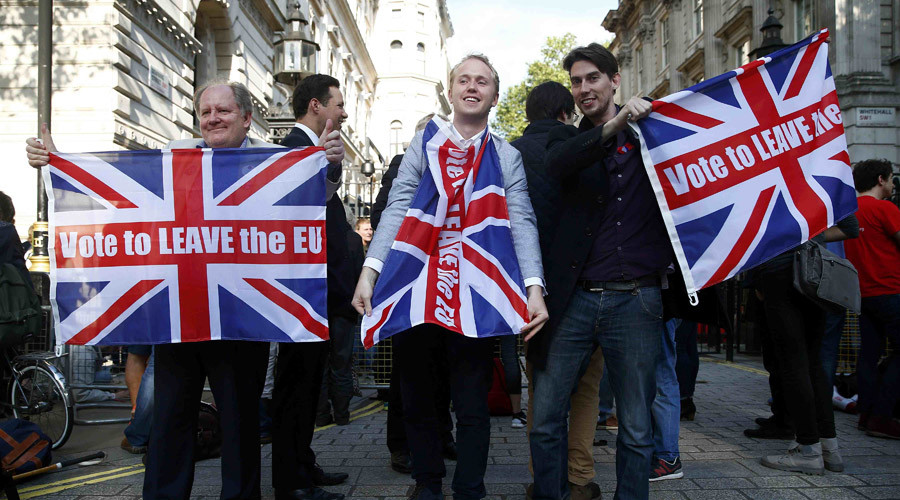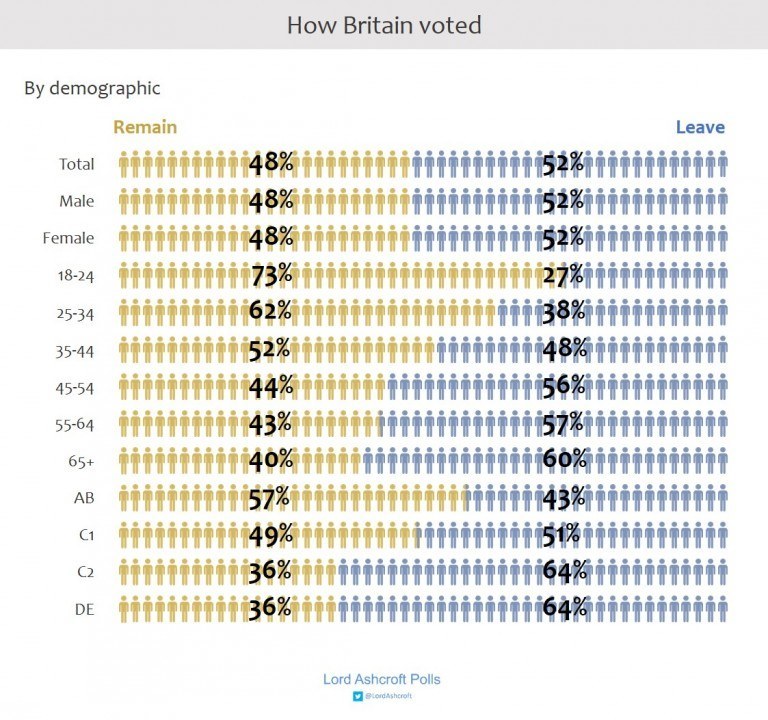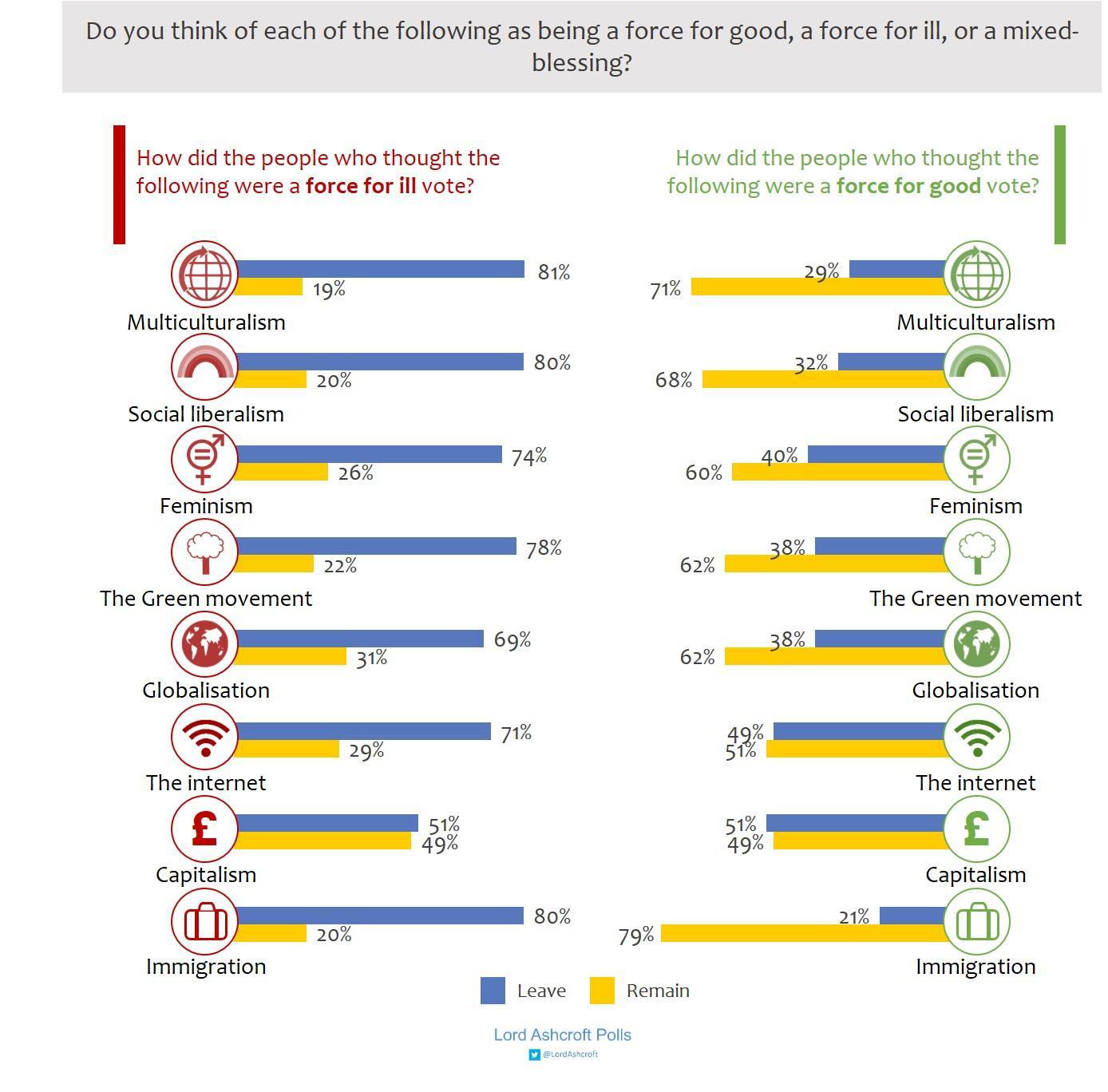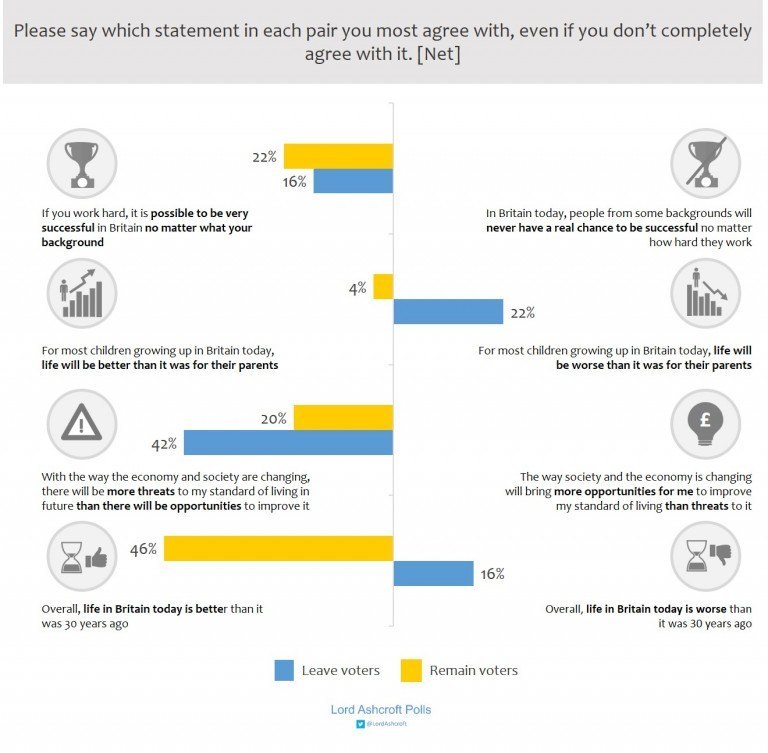Britain: what was behind the 'Brexit' vote?

Seeing the whole picture after the referendum
By Charlie Hore "I love the smell of napalm in the morning--it smells like victory." – Apocalypse Now June 28, 2016 – Socialist Worker – THE Left urgently needs an honest assessment of where we are and what we have to do in the aftermath of the UK referendum on the European Union. These are some hastily written notes toward that assessment. The starting point has to be understanding what drove the campaign. Of course there were anti-racists who voted to Leave, and racists who voted to Remain. But the driving force of the Leave campaign was always racist ideas, and they became increasingly the cutting edge as the campaign progressed. Equally, when the Remain campaign began to pick up in the last week, one of the key drivers was revulsion first at UK Independence Party (UKIP) leader Nigel Farage's poster of Syrian refugees and then at the murder of Labour Party member of parliament Jo Cox. The campaign against Jeremy Corbyn makes this very plain. Corbyn is being targeted by the right specifically because he failed to respond to "legitimate concerns about migration" expressed by "traditional Labour voters." Rather than go after the Tories, the Labour right would rather bring down their own leader. The trouble is, from their perspective, it makes sense. Cameron's finessing of the Tory leadership crisis makes an immediate election less likely. If you really believe that Corbyn cannot win back those "traditional voters"--the political shorthand for older white Labour supporters--best remove him now and get someone who will pander to the toxic atmosphere of racism that the campaign and the result have produced. A fellow British socialist, Pete Gillard, made the important point on social media that we need to distinguish between hardcore racists and people who hold racist ideas. And we need also to understand that racism mutates and changes. The two key forms at the moment are Islamophobia and racism against EU migrants. The latter is often expressed in economic, non-bigoted sentiments like "We're full, "There's no more room" and "We should look after our own first," which seem miles removed from open bigotry--although the reported increase in physical attacks on both Eastern European and Asian people since the result show that the two are not unconnected. Of course, we need to understand that much of the Leave vote came out of a revulsion against poverty and austerity, but that is far from the full picture. The racism that drove the campaign isn't a thin veneer that can simply be peeled away. - - - - - - - - - - - - - - - - We should be very wary about celebrating the result as simply a working-class revolt against the elite, particularly given the results of the Ashcroft poll. Lord Ashcroft is a member of the British House of Lords--his organization surveyed more than 12,000 people to find out why they voted Leave or Remain, It's so far the best dataset for understanding the results. The poll shows that the vote split working-class opinion down the middle. And we should be equally wary of the way that the occupational categories ABCDE are being used to bolster this argument. AB includes 25 percent of the population, including key groups of workers who have been in struggle recently--teachers, nurses, doctors and other health professions--and, in fact, most trade union members. A majority of people in full-time or part-time employment voted for Remain. C2-- skilled manual workers--split 50/50. And the DE figure is skewed by the very large turnout among pensioners. Tellingly, according to the poll report, "White voters voted to leave the EU by 53 percent to 47 percent. Two-thirds (67 percent) of those describing themselves as Asian voted to remain, as did three-quarters (73 percent) of Black voters. Nearly six in 10 (58 percent) of those describing themselves as Christian voted to leave; seven in 10 Muslims voted to remain." This tells us both that racism and the experience of racism was a real factor, but also that this is still highly contested. We have to be concerned, but we're not facing a tidal wave against which we are powerless. The vote divided the working class, and while the left, of course, have to reach out to those who voted to leave and not write them off, in a lot of the struggles to come, a great many Remain voters are going to be our allies. Two further aspects to this. The first is the youth vote--75 percent to remain, though on a low turnout--and the widespread anger reported about "old people deciding our future." We should not turn our backs on that. The last point is Scotland and Northern Ireland--more working-class than England and Wales, and in some places just as poor. But every district in Scotland voted to remain, as did nationalist/Republican areas of Northern Ireland. It's an odd "working-class revolt" that doesn't include Scotland, West Belfast, Liverpool, Manchester, Leeds, Bristol, London, most union members, most Black and minority ethnic voters, and three-quarters of young voters. The sad reality is that the immediate priorities for the left are defensive--standing up for refugees, migrants and migration, and stopping the coup against Jeremy Corbyn. None of this is to downplay the very real long-term crisis of the Tories and of British capitalism. But immediately, our side is in a poor position to take advantage of that. It's by no means impossible that Corbyn will be gone before Cameron. This smells like something, but not victory. Charlie Hore is a member of Revolutionary Socialism in the 21st CenturyMaking sense of the Brexit tide of reaction and the reality of the racist vote
By Andrew Flood June 27, 2016 – Workers Solidarity Movement – The Leave / Brexit vote in the referendum came in the end as a surprise, a narrow win for Remain was expected. This may be because the core Leave vote was in the run-down white working class communities of the now desolate English and Welsh industrial zones. A population trapped in conditions of long-term unemployment and poverty who no one really pays much attention to anymore. Some on the left have seized on the makeup of this core vote to suggest that there was some progressive element to the Brexit vote despite the campaign being led by racist hatemongers and wealthy US-oriented neoliberals. Mostly that’s a mixture of wishful thinking and post hoc justification for having called for a Leave vote in the first place, but it is true that a section of the working class, C2DEs in marketing speak, voted to Leave in close to a 2:1 ratio. Is the class composition of that vote enough to automatically make it progressive regardless of content? And what does it tell us that a section of the radical left seems to think the answer to that question is yes, that it is enough to be anti-establishment?Or was it that this is the story of a sizeable enough, but still minority of the working class, with reactionary ideas being energized and mobilized by the toxic racist nationalism of the English colonial project. Essentially a whipping up of all those older racist relatives that turn up at family events and that everyone wishes would just shut up? Something like Donald Trump has managed to do, using similar rhetoric about migrants and elites, in the USA, ‘Take our Country Back’ could well be a Trump slogan, ‘Make Britain Great Again’ could well have been the Leave slogan. From anecdotal stories, geographic voting and most importantly actual polling of 12,000 voters it becomes clear that these communities, who were smashed by neoliberalism from Thatcher to Blair, were successfully tricked into taking aim at the wrong target in order to ‘take our country back’. But it goes deeper than trickery, the poll results make clear that many of the Leave voters hold a toxic blend of reactionary views, glued together by the common cement of English colonialist nationalism. And ‘English’ is the correct term, one fascinating aspect of one voter survey is that 79% of Leave voters identify as English rather than British, while 60% of Remain votes identified as British not English. The geographical breakdown of votes indicates that with important exceptions (Scotland, Wales, London) the areas with the highest Leave votes were those hardest hit by the neoliberal restructuring of the UK economy. According to the Times (article behind paywall)- 86% of Local Authorities (LAs) with a high number of manufacturing jobs voted Leave
- 82% of LAs where more than 25% of the population lacked good GCSEs voted Leave
- 77% of LAs with average weekly earnings below 452 pounds voted Leave
- 75% of LAs where more than 87% of the population is white voted Leave We can dig into the motivations of those who voted further because of polling of 12,000 people who had voted by Lord Ashcroft Polls. Michael Ashcroft is an interesting character, the former Deputy Chairman of the Conservative Party and the 74th richest man in Britain, the Sunday Times reckons he was worth 1.32 billion in 2015. The polling seems to be part hobby, part philanthropy, or as he puts it “if it doesn’t sound too pompous, there is an element of public service in keeping politicians on their toes”. He is pro Brexit so the damning nature of some of what follows isn’t a result of bias against Leave voters since he is one. In any case it’s frequently the case that after an election or referendum you wish you had information about who voted which way and why they did so. Endless arguments go on based on people’s presumptions about this. Ashcroft did us a huge favour. “On referendum day I surveyed 12,369 people after they had voted to help explain the result.” Political parties do this sort of polling all the time but seldom release results unless they can make particularly favourable stories out of them. And this isn’t a favourable story.

5148 = A+B
3179 = C1
1653 = C2
2360 = D+E In other words, if you took the working class / middle class labels of the CRS system at face value then, for this poll, voters in the UK referendum were 33% working class, 67% middle class with no ruling/capitalist class, not even as the often over stated 1%. These figures are partially so low because voting is always disproportionately dominated by ABC1s with relatively larger numbers of C2DEs staying at home. The C2DE composition in the UK population is considerably higher than in the vote poll, the NRS classification in 2015 gave 46% in their C2DE definition of working class and 54% as middle class. Instead we would work off looking at whether people have to make a living through working for others (the working class), have enough skills, tools and space to independently work for themselves (the middle class) or have so much wealth that most of their income comes from having the rest of us work for them. For the UK that would give you more of a 80%+ working class, 20%- middle class and 1%- ruling class, with the actual section of that class that rules being more like the top 0.01%. But in any case what the Ashcroft polling tells us is that for the C2DE categories, which are working class by any definition, 64% of those who voted chose Leave. This is way ahead of the national average of 51.9% for Leave. National averages are broad categories that can disguise a lot of important data so let’s not confuse that 64% as ‘the working class’. It’s not, it’s just a big segment of that part of the class that depends on doing manual work. Importantly a big section of this part of the working class didn't vote on the day - the Ashcroft poll only talked to people who had voted and as we shall see this is an important distinction. What was the turnout of C2DE voters? Voter turnout was around 72%, differing a bit by region. But as we already recognised, voter participation is not equal across classes, far more ABC1s vote than C2Des, arguably because the C2DEs understand that politicians in power only listen to the As. So we can be fairly sure less than 72% of C2DEs voted, the question is how much less. The Ashcroft poll enables us to make a good guess at this. C2DEs are 46% of the UK population but only 33% of the Ashcroft poll, that missing 13% indicates the scale of the higher non-voting rate. Using that gap a reasonable quick estimate would be that turnout for C2DE was possibly slightly less than 52% of those registered. (Ben Pritchett did some proper maths on this ) But we also need to do a few final subtractions. The first is of people entitled to vote but not registered, that number I haven’t been able to estimate but it’s probably not huge. The second is those not yet of voting age, who I’m going to ignore beyond noting that because the young overwhelmingly voted Remain it’s probably the case that most of these would have been Remain. The third subtraction is far more politically important: migrants who were not from the former colonies (the Commonwealth and Ireland) and who therefore did not get a vote. In terms of migrants from other areas of the EU that’s over 2 million people excluded from the vote – a shocking figure when you consider the vote was essentially on their future. And migrants not from the Commonwealth or Ireland also number in the hundreds of thousands. Remember less than 1.3 million votes separated Leave from Remain, if the 2.5 million plus migrants had been allowed to vote on their own future Brexit probably would not have happened. It’s an important aside, and the point to make here is that these migrants are overwhelmingly working class and therefore their exclusion from the vote reduces further the proportion of the C2DE working class that actually voted leave. How many C2DE working class Leave voters were there? Some very crude maths now. The population of the UK at the time of the last census was 63 million. If 46% were C2DEs this gives about 30 million people, about 23% of whom were below voting age, so about 22 million. From this we need to subtract the C2DE immigrants who can’t vote, let’s guess about 1 million people. Of the 21 million remaining we’ve worked out above that about half voted, so 10.5 million, or 1/3 of the total voters. Out of that the Ashcroft poll suggests 64% voted Leave, that’s 6.7 million people. 6.7 million is also about 39% of the total Leave vote. As the Leave vote totaled 17.4 million we see Leave was also mostly ABC1s even though it captured almost 2/3 of voting C2DEs. I wanted to do these calculations because it’s going to become clear that the many Leave voters are pretty damn reactionary and not just on migration. And a section of the left that foolishly advocated a left Leave vote are now defensively trying to exaggerate the ‘working class’ composition of the Leave vote as a form of strange self-justification. The reality is that a significant section of the white English working class buys into English colonial nationalism and has backed some terrible right wing figures from Enoch Powell to Margaret Thatcher as part of that. The core of the C2DE Leave vote seems to be an expression of that bloc, not an expression of the C2DE working class as a whole. The relatively high percentage of C2DE voters voting Leave (64%) is as much because the campaign mobilised those hostile to migrants whereas there would be few C2DEs with any love for the EU. From the calculations above we see that even if we restrict the working class to C2DEs, only 23% of the C2DE working class actually mobilised to tick Leave. If we exclude those too young to vote that rises to about 32%. So, for a variety of reasons, including being denied a vote, 68% of the C2DE working class of voting age did not vote Leave. We’d speculate that amongst that number are a substantial amount who were horrified by the racist nonsense of their neighbors and relatives but who were not going to save the establishment by voting Remain. Perhaps a major motivation for the 18% who did vote Remain was opposing those racist neighbours, in particular as that 18% was probably drawn from the sizeable number of C2DEs that are not white. Even of those C2DEs who were allowed to and did vote, some working class areas of London, for instance Tottenham and Walthamstow, voted overwhelmingly for Remain. The same may well be true of Scotland, and some of the bigger cities of the UK. From the referendum returns it appears the Leave C2DE vote was concentrated in smaller cities, towns and villages, and the further out suburbs. What was the ‘working class’ Leave vote? When you compare his data with the geographical results it becomes clear that the huge working class Leave vote was a citizen white C2DE working class from those areas that have been decimated by neoliberalism, in particular the once industrial and mining north of England and Wales and the agricultural counties of the south. Of course the north of England and Wales have comparatively fewer migrants than in Remain-voting London because there aren’t that that many available jobs. This maps onto a common observation that in electoral terms the far right tends to do well in areas where there are not actually as many migrants as the areas they do badly in. Its racist fear rather than reality that garners them support. In the agricultural south, a much grimmer story is found as agricultural work is sometimes dominated by gangster capitalists with groups of insecure migrants under illegal pay and conditions under their control. This is typical of agricultural work in the wealthier countries where regardless of migration controls the state allows situations that create pools of very cheap insecure labour with raids and deportations serving to maintain that insecurity and prevent organising. So what has caused a large enough section of the C2DE working class to scapegoat migrants in the process of siding with one particular gang of rich white neoliberals? Yes there is competition for jobs & houses but not only is the scarcity that creates competition a product of capitalism it’s also the case that the worst racism is not found in the areas where there is greatest competition. Housing is at its most expensive in Leave voting London, costs are not only lower in the old industrial zones but in many cases there is a large amount of empty housing stock visually demonstrating that a shortage of decent housing is not down to a lack of buildings. So what is it that can glue some of those living in the poorest and more marginalised districts to rich white millionaires like Farage and Boris? Clearly racism was one of the mechanisms used, in particular by Farage but the answer is deeper than that and quite visible in the Ashcroft polling and the referendum material produced by the Leave side. The answer is in ideology and in particular the toxic ideology of English nationalism, a nationalism steeped in ideas of colonialism, empire and monarchy. Just before the referendum The Daily Mail produced a Leave poster for its windows of a 100m high Norman crusader knight with the St George cross on his shield gazing with hostility out to sea from the cliffs of Dover. His speech bubble reads, “We demand our country back.” When a friend first shared this on Facebook I presumed it was a piss take, but nope it was the real thing. It stands in as a good visual representation of the sort of hyper masculine, militaristic English nationalism that has such a deep hold over English workers, one that has always been used to bind them to their masters. But enough of symbolism, on to some figures about what Leave voters think, 39% of whom are C2DE workers. The heart of reaction We can start by repeating the very direct figure that “79% of Leave voters identify as English rather than British”. But the post vote polling gives us a load of information on what voters thought about some key reactionary / progressive dividing lines.

